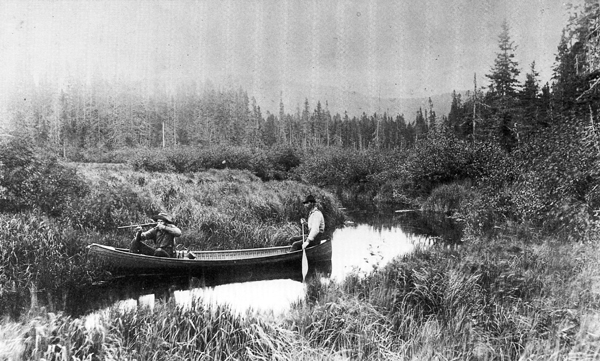B A C K T H E N
Tight as a Drum, Round as a Dollar

Late 1880s, on beaver ponds northwest of Rangeley. (The print’s inscription reads “Arnold’s Bog”— which is located in an intruding tongue of Quebec—and “Parmachenee,” a nearby Maine wild township and lake.) Before its near extermination beginning in the 1600s by Indian trappers and European fur buyers, the dam- (and wetland-) building beaver had extensively affected the natural condition of vast areas of the North American continent.
Al Snowman, Walt Twombly, and Rafe Crosby, three old hunters and trappers of Rangeley, left the “city” about four weeks ago for the forests, to hunt and trap, taking with them one of F.C. Belcher’s canvas boats to use on ponds, etc. They arrived the next day [via Kennebago River] at Seven Ponds [Township] .... They have a line of traps in that region, and after staying around them a few days and setting up more traps, they started on a caribou hunt on Snow Mountain. After hunting awhile they came upon a large caribou and then the sport began. It took five shots from their rifles to bring him down. He was very large with a splendid pair of horns. After dressing him they started for other places in the direction of Arnold’s Bog. Not meeting with success, they started for home .... As they were rowing along [Kennebago Lake] they saw a deer swimming from one point to another. They gave chase and soon came within gunshot, when a ball from Rafe’s rifle ended his life. After taking him into the boat they continued up the lake, where they arrived in time to partake of one of Corneil’s good dinners. That night they came home. It is understood that a gentleman in Gardiner is to have the head and antlers of the caribou, for which the hunters are to receive $50 .... Next Saturday they start again for the forest, to be gone all winter trapping and hunting. —Phillips Phonograph in The Maine Mining & Industrial Journal, Dec. 7, 1883.
Al, Walt, and Rafe’s boat was likely shaped very much like this one, although constructed canoe-style, with flat frames and covered with canvas. The lapstraked boat pictured is framed with square stock, has no canvas covering, and qualifies as a “Rangeley,” or “guide boat.” It may be rowed from the bow thwart; there is no center thwart, the better to carry a deer. Such craft were well suited for retrieving deer killed after being driven into the water by dogs, a favored method of hunting in up-state New York, where the type originated. Guide F.C. Barker of Rangeley recalled his first such boat, from the ’70s:
I think one of the best investments I ever made was parting with sixty hard-earned dollars for one of the first six Indian Rock boats .... They were lap-streaked cedar boats, shaped much like a canoe ... and about sixteen and a half feet long .... When the old guides first saw the boat, they told me I had fooled away my money, for the boat would not stand either baggage or rough weather. In this they soon found themselves mistaken.
In October 1876 Barker and fellow guide J.S. Danforth started out from Errol, New Hampshire, with the Indian Rock boat and a smaller Rushton (J. Henry Rushton of Canton, New York, was the premier guide boat builder). Loaded in the boats were four hundred steel traps, a change of clothes for each, blankets, flour, oat and corn meal, molasses, sugar, salt, tea, axes, hatchets, drawknife, and other tools, two Ballard rifles and two thousand cartridges, and other supplies necessary for a “winter’s campaign against the animals in the Magalloway River country north of Parmachenee Lake.”
Caribou meat was the core of their diet; caribous’ habit of gathering around a fallen comrade allowed the hunters to kill eight out of a group of twelve. They preserved the frozen meat by tying it to the tops of springy trees.
Trapping beaver proved difficult until they hit upon the idea of draining a large beaver pond. Beaver skins, removed with great care, and stitched to bent alder hoops, became as “tight as a drum-head, round as a dollar.” Otter skins were removed like a bag, stretched open with wedged sticks. The partners were all business—once they watched two unsuspecting otters playing, “tumbling about like kittens,” but “could not resist the temptation to shoot,” and, counting to three, bagged them both.
With the arrival of the spring thaw they hid their traps, bundled up their harvest, and returned to civilization. A Boston dealer paid them $628.60 for the skins of twenty-nine mink, nine otter, fifteen fishers, two bears, one fox, sixty-five beaver, one hundred and fifty-two muskrats, six lynx, and forty-nine martins. (Fur prices were high in the ’70s, due to European demand.) They also sold the caribou and deer horns, and spruce gum.
Danforth was a shrewd and pioneering Rangeley Lake sporting camp owner, lake steamer owner, and tourism promoter. The intended audience for his book was the urban “sportsman” who, like so many Americans of that era, confused wildlife appreciation with wildlife annihilation.
Text by William H. Bunting from A Days Work, Part 1, A Sampler of Historic Maine Photographs, 1860–1920, Part II. Published by Tilbury House Publishers, 12 Starr St., Thomaston, Maine. 800-582-1899.
